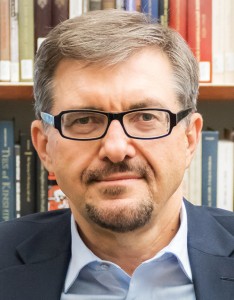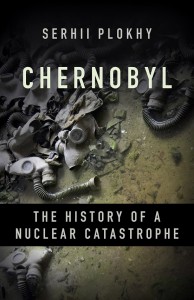Behind the Book | Interactions: Conversation with Serhii Plokhy
Published in Physics

 Serhii Plokhy is professor of history at Harvard University and author of the book ‘Chenorbyl – The history of a nuclear catastrophe’, released last week. In his book, he tells the complete history of the nuclear disaster of Chernobyl, from the Soviet excitement about nuclear energy, to the details of the explosion of unit 4, the clean-up, the devastating effects for the people living in Pribyat and the political consequences, culminating in Gorbachev’s policies of glasnost and perestroika and ultimately, the end of the Soviet Union. In Serhii Plokhy’s book, the reader gets to know the personalities involved in the Chernobyl disaster – the director of the nuclear power plant and his family, the operators, the firemen known as liquidators, the doctors in the hospitals trying to handle a disease that they were not trained to treat and the Russian and Ukrainian politicians, who tried their best to hide what had happened. Serhii Plokhy’s book is as compelling as a novel and describes this tragedy not only from a scientific, but also from a political and personal perspective, which makes it a strong testimony to the good and bad of science, and to what can happen if political and scientific responsibility is not taken seriously.
Serhii Plokhy is professor of history at Harvard University and author of the book ‘Chenorbyl – The history of a nuclear catastrophe’, released last week. In his book, he tells the complete history of the nuclear disaster of Chernobyl, from the Soviet excitement about nuclear energy, to the details of the explosion of unit 4, the clean-up, the devastating effects for the people living in Pribyat and the political consequences, culminating in Gorbachev’s policies of glasnost and perestroika and ultimately, the end of the Soviet Union. In Serhii Plokhy’s book, the reader gets to know the personalities involved in the Chernobyl disaster – the director of the nuclear power plant and his family, the operators, the firemen known as liquidators, the doctors in the hospitals trying to handle a disease that they were not trained to treat and the Russian and Ukrainian politicians, who tried their best to hide what had happened. Serhii Plokhy’s book is as compelling as a novel and describes this tragedy not only from a scientific, but also from a political and personal perspective, which makes it a strong testimony to the good and bad of science, and to what can happen if political and scientific responsibility is not taken seriously.
We talked to Serhii Plokhy about his new book and the stories behind it.
How did the idea for the book ‘Chernobyl’ take shape?
I was interested in the topic for quite a while — after all as someone who lived in the Ukraine in 1986, I knew very well that my own life and the life of many of my friends were affected by the catastrophe. The final decision came on a trip to the Chernobyl Exclusion Zone. I realised then that I had to tell the story of Chernobyl for those who were not around at the time.
How was your visit to Pripyat? Would you recommend it?
It was a useful experience, not only for me as a historian and a writer, but also as a human being. You have to see this place to understand the enormity of what has happened and to feel how vulnerable we are as humans.
Why did you write this book now? Did you have access to research material that was not available before?
Yes, I did. The Maidan protests of 2014 resulted, among other things, in an archival revolution, which helped to ease access to the former state and KGB archives. The newly released materials from the Ukrainian archives allowed me to conduct research that was impossible to do before.
What was, in your opinion, the most surprising or shocking fact that you came across during your research on the book?
No one knew what to do in case of a radiation emergency. The key figures in the government, upon receiving KGB and other reports with the radioactivity data, kept asking: ‘What does this mean?’ But most shockingly, the fire fighters who put down the radioactive fire at the expense of their lives were not trained to deal with radioactivity, and the doctors at the local hospital at the nuclear power plant knew nothing about acute radiation syndrome and its symptoms.
From your perspective, could the chief engineers have prevented the accident? Or was this bound to happen at some point owing to the design of the reactor and the test?
That particular accident would not have happened if the operators have not violated numerous regulations and safety procedures. However, sooner or later, the confluence of factors would have led to a Chernobyl type disaster, because the RBMK reactor (Reaktor Bolshoy Moshchnosti Kanalniy – a graphite-moderated nuclear power reactor) was not safe to start with. Moreover, to save extra money, they ‘forgot’ to build a concrete confinement over it.
In your book, you draw the connection between scientific and technological progress and politics and society. How do you think the field of physics and especially the role of physicists have changed in the Soviet Union and subsequently in the Ukraine and Russia because of the Chernobyl accident?
The major changes took place in the safety culture. Now, everyone knows that reactors can explode, and the people responsible have to ensure that a Chernobyl type disaster does not happen again. Moreover, the nuclear industry in both countries is now much more open to cooperation with the rest of world and abides by international safety standards. This was not the case before Chernobyl.
Following the same thought, how much influence do you think science (and scientists) can have on politics and society today?
 As Chernobyl opened the door for Gorbachev’s policies of glasnost and perestroika, the scientists found themselves at the forefront of the fight for democracy. In Russia, Andrei Sakharov became a leader of the democratic opposition. In the Ukraine, the parliamentary opposition to the communist government was led by another physicist, Ihor Yukhnovsky. In Belarus, his colleague Stanialau Shushkevich became the head of the parliament and signed the documents on behalf of Belarus dissolving the USSR. The physicist Askar Akayev became the first democratically elected president of Kyrgyzstan.
As Chernobyl opened the door for Gorbachev’s policies of glasnost and perestroika, the scientists found themselves at the forefront of the fight for democracy. In Russia, Andrei Sakharov became a leader of the democratic opposition. In the Ukraine, the parliamentary opposition to the communist government was led by another physicist, Ihor Yukhnovsky. In Belarus, his colleague Stanialau Shushkevich became the head of the parliament and signed the documents on behalf of Belarus dissolving the USSR. The physicist Askar Akayev became the first democratically elected president of Kyrgyzstan.
However, the economic crises that engulfed the post-Soviet countries in the 1990s delivered a major blow to the standing and influence of science and scientists in the post-Soviet societies. Scientists are not anymore what they used to be, even in the Soviet Union, when the arms race was forcing the Moscow potentates to pay attention to what the scientists thought and wanted.
Is there anything you ended up not including in the book but would like to share now?
Yes, a lot of the history of the place, which is known to the world as Chernobyl, but is spelled in Ukrainian as Chornobyl, did not make it into the book. Chernobyl has a long and interesting history as a city, starting with the Kyivan princes in the twelfth century. It includes the history of the Hassidism in Eastern Europe—the Chernobyl rabbis used to be among the most respected in Ukraine. I did a fair amount of research on the history of the region, including its Cossack past and the history of the Great Ukrainian famine of 1932-1933, but decided at the end that it was not relevant to the accident itself, which is the main focus of the book.
What do you hope the readers to take away from the book? What reactions do you expect?
I want the reader to understand that science can be a force for good and bad, depending in which hands its results end up. This is especially true for nuclear science. While individual countries and rulers take the decisions on how to use science, it is the world as a whole that picks up the bill for mismanagement and disasters like the one that took place at Chernobyl. We should strengthen the international control over nuclear energy—that is the main takeaway, at least for me.
I grew up in Austria and I remember the Chernobyl accident very well, as we kids were not allowed to play in the garden for weeks after the accident (which we could obviously not understand). Where were you when the accident happened? What is your personal memory?
Me and my family, including two small children, lived 500 kilometres downstream the Dnieper River from Chernobyl. After the accident, our kids were locked inside for the entire summer. However, the advice to stay inside and close the windows did not come from our government, as was probably the same in your case, but from Western broadcasts. The Soviet regime could not protect its citizens from radiation, so it ‘protected’ them from information about radiation. Nuclear energy is most dangerous in the hands of authoritarian regimes. This is another takeaway message of the book.
The book: https://www.hachettebookgroup.com/titles/serhii-plokhy/chernobyl/9781541617094/


Please sign in or register for FREE
If you are a registered user on Research Communities by Springer Nature, please sign in